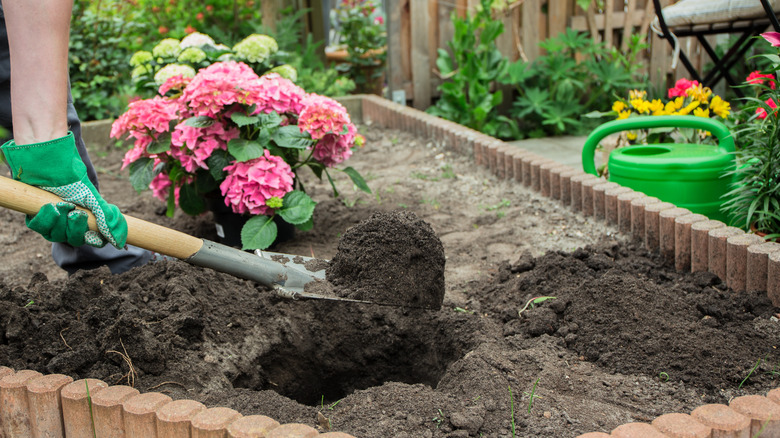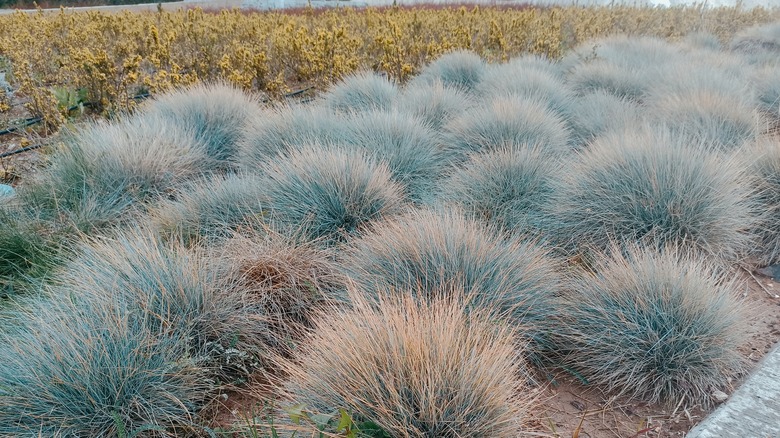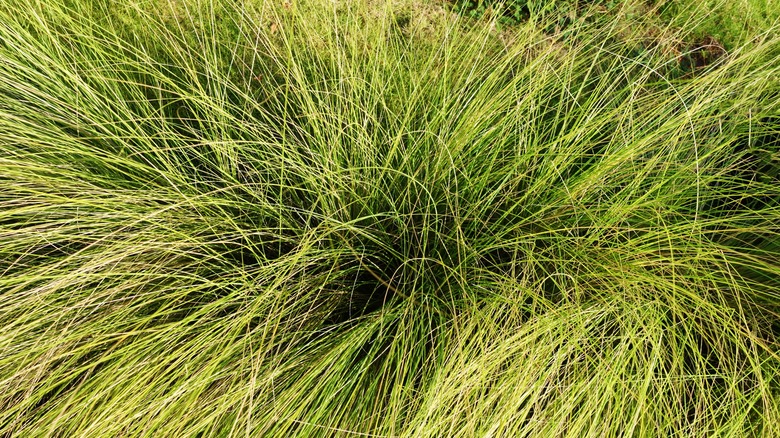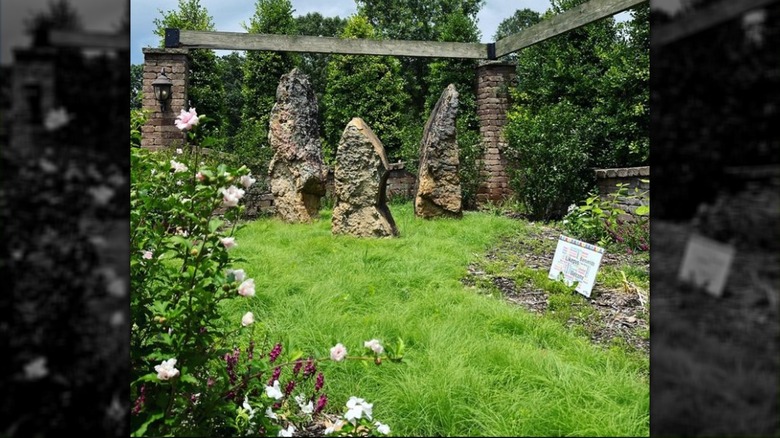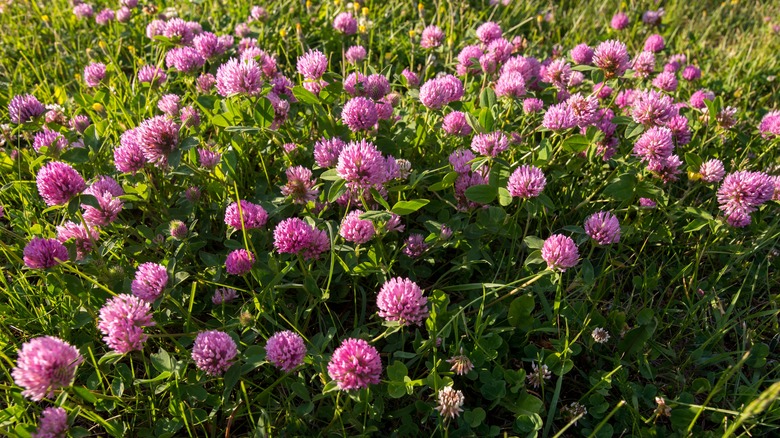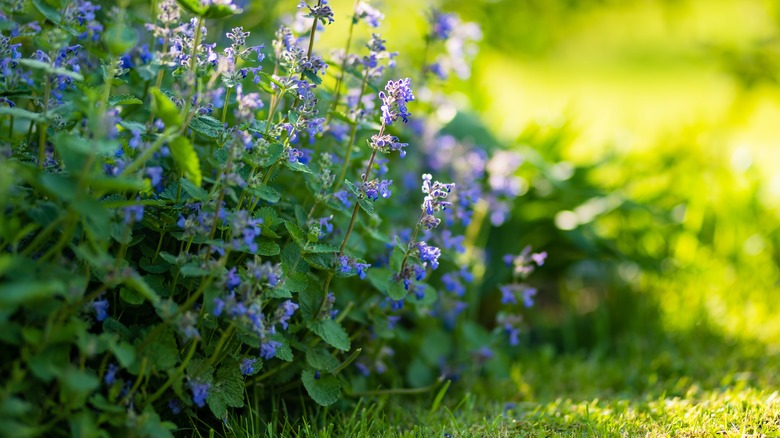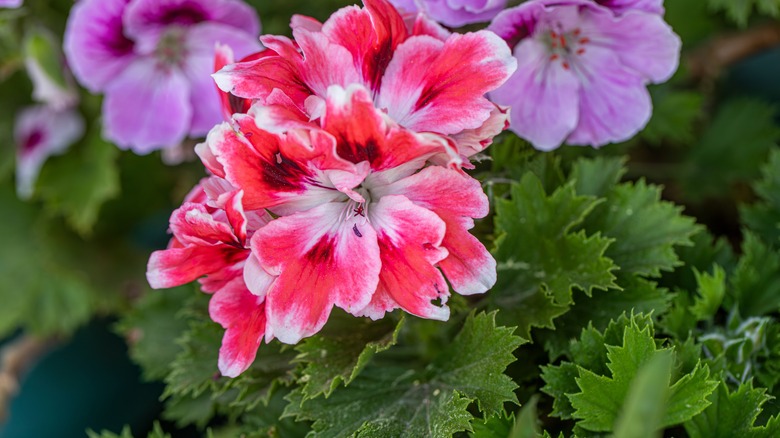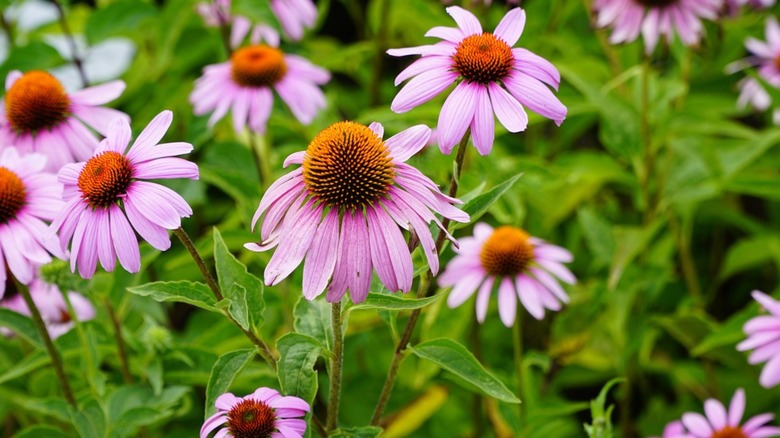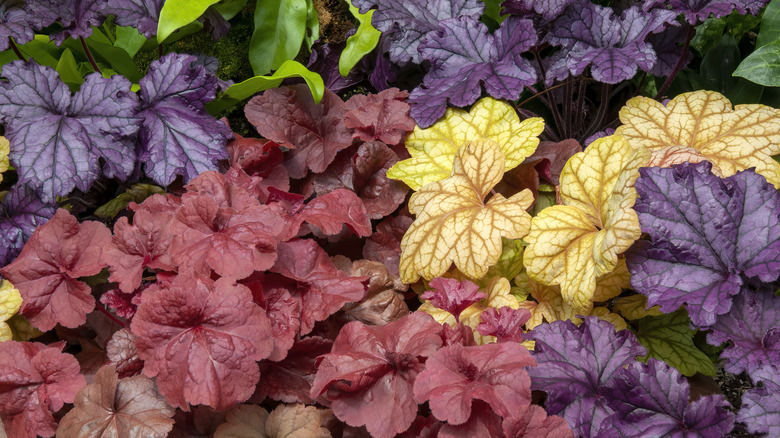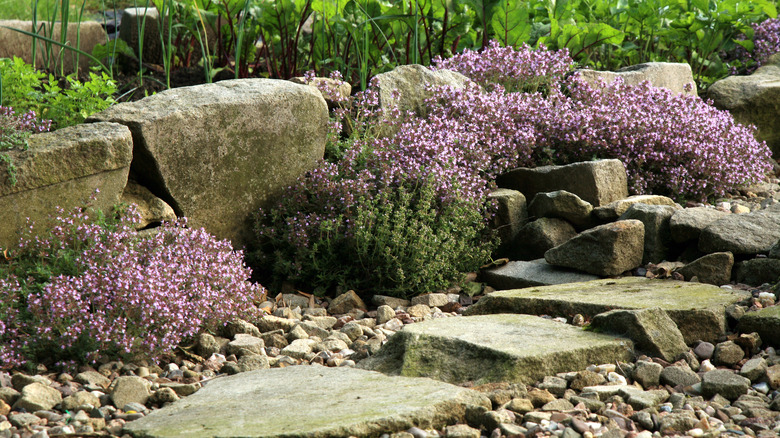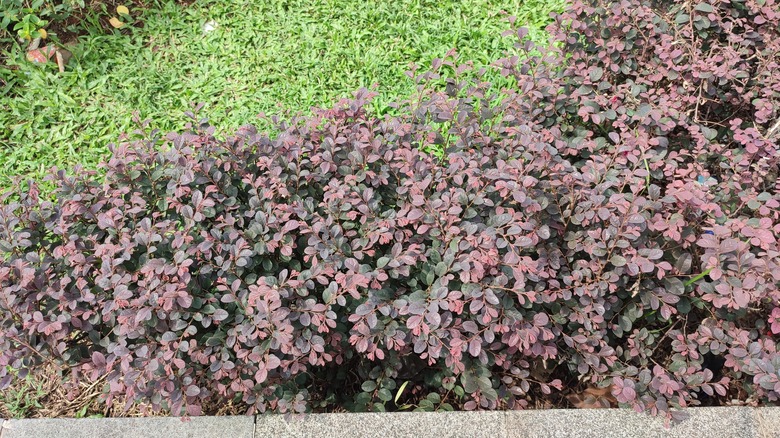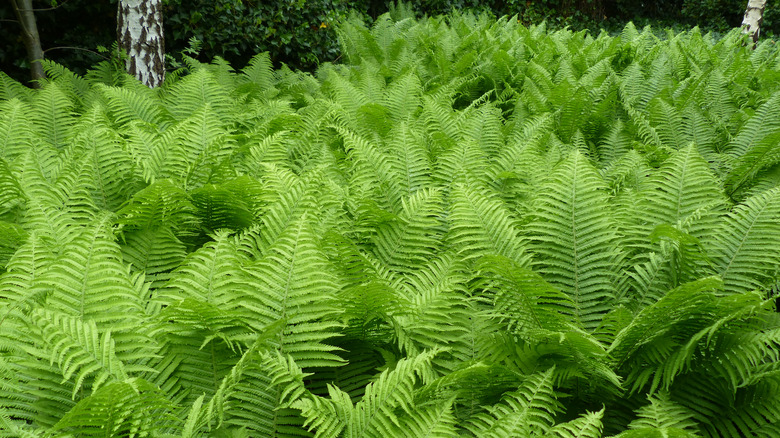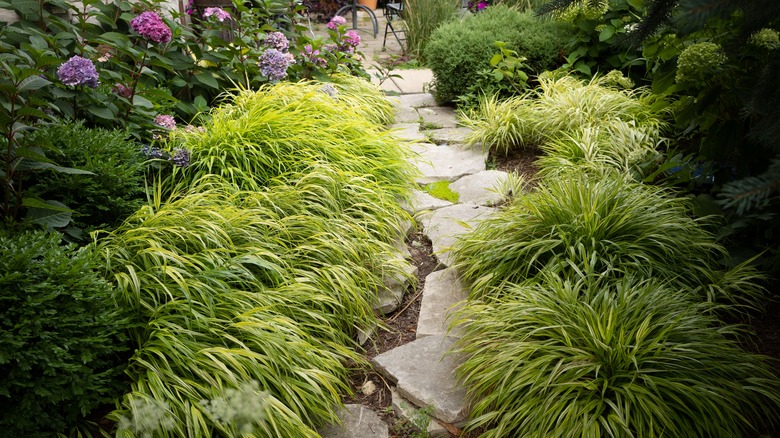12 Beautiful Ground Covers That Work Perfectly Under Hydrangeas
Hydrangeas are a show-stopper in any garden, but it can be tricky to fill in the bare spaces around them. When hunting for companion plants for hydrangeas, it's crucial that the plants share similar care needs. Most hydrangeas prefer acidic soil, especially if you're trying to achieve those iconic blue flowers, so it's important to choose companions that can tolerate the slightly sour conditions. Hydrangeas thrive in partial to full sunlight, and although they can grow rapidly, they have relatively shallow root systems that spread outward.
Ground cover plants can be helpful to lock in some soil moisture for these shallow roots and create a barrier against weeds, but it's important that they don't compete for resources. Plants with more compact root systems may also be a good choice. Hydrangeas can also struggle with fungal issues like powdery mildew and Cercospora leaf spot, so any ground cover and companion plants must not be too tall to allow for good airflow and sunlight around the base of the bush.
While these are the general rules you'll need to consider around your hydrangeas, you should also plan for the specific type of hydrangea you have, as growing conditions may vary. Even with these factors in mind, there are still several options for ground cover near your hydrangeas, such as blue fescue grass, red clover, lady fern, and more. Whether you're looking for something lush and leafy or short and subtle, here are 12 ground cover plants that can bring beauty and other benefits to your hydrangea garden.
1. Blue fescue grass
Blue fescue (Festuca glauca) is a classic ground cover option in lawns and gardens, especially the Elijah Blue cultivar, and its care needs make it very compatible with hydrangeas. With lush clumps that grow just under 12 inches tall, blue fescue grasses are some of the best colorful plants to grow in your garden that aren't flowers, turning their famous silvery-blue color when grown in full sun. Blue fescue grows happily in USDA zones 4 through 8 and is drought-tolerant with tight, clumping roots in a wide range of soil conditions.
2. Carex sedges
Sedges belonging to the Carex genus are another great choice to bring texture, color, and ground coverage to a hydrangea garden bed. With many varieties native to North America, sedges have long been touted as a more eco-friendly and low-maintenance alternative to typical grass lawns. Species like Pennsylvania sedge grow beautifully in the acidic soil and partial shade near hydrangeas and form dense, feathery mats that are some of the first greenery to emerge in spring. Sedges can also be tolerant to sunnier or shadier conditions, and they tend to be resistant to droughts, deer, and insect pests.
3. Buffalo grass
Buffalo grass (Bouteloua dactyloides) is native to the plains of North America and can be a brilliant choice for native gardens with hydrangeas. When left untouched, buffalo grass blades can reach up to 12 inches long, but they tend to curl over, forming a soft blanket of ground cover, perfect for offsetting hydrangeas. This perennial warm-season grass is remarkably drought-tolerant, growing in a variety of soil types except sand. Buffalo grass needs at least six hours of bright sunlight, so plant it near hydrangeas that have also adapted to full sun.
4. Red clover
For hydrangeas grown in partial shade, red clover can be a smart ground cover option to help lock in soil moisture and prevent weeds from taking over. Unlike most grasses, red clover (Trifolium pratense) can survive in shady conditions. Red clover will grow in slightly acidic to neutral soil, and its blooms are very attractive to pollinators. Clovers naturally boost nitrogen in the soil, acting like a natural fertilizer. However, you'll want to avoid using a heavy nitrogen fertilizer on your hydrangeas if you have clover, as this can lead to rapid foliage growth and a lack of blooms.
5. Catmint
Catmint, also known as Nepeta, is a member of the mint family and a great companion for hydrangeas grown in full sun and a variety of soil types. Catmint will thrive in USDA zones 3 through 8 and grow under 3 feet tall, depending on the variety. Catmint has long-lasting spire-like purple blooms, so it's perfect for filling in the garden between hydrangea blooming periods. While the plants are related, catmint is not the same as catnip, so you won't have to worry about all the neighborhood cats lounging in your garden beds. Catmint can grow rapidly, which is awesome for filling lots of space, but it may require some occasional culling to keep it from taking over your yard.
6. Geraniums
Geraniums consist of a large group of popular garden flowers, also commonly called cranesbills. These cheerful perennial flowers will grow best in full sun, but can tolerate partial shade and require relatively low heat and humidity. Geraniums offer a classic garden look with low-lying foliage and eye-catching, colorful blooms. When planted as ground cover around hydrangeas, geraniums can be helpful to keep the soil cool and block out weeds. Most geraniums are chosen for their lovely blooms, but some varieties like scented geraniums, could also protect against pests that will destroy your hydrangeas.
7. Coneflowers
If you're looking for ground cover that goes beyond your typical grass, coneflowers are an unbeatable choice in your hydrangea garden in terms of both color and coverage. There are many different types of flowers in the coneflower genus, also known as Echinacea. These perennial flowers will survive in USDA zones 3 to 9 and are drought-tolerant and a magnet to pollinators. Coneflowers bloom from mid to late summer, vary in shades of orange, pink, purple, and yellow, and rarely reach above 3 feet tall, depending on the variety.
8. Huechera
Opt for Huechera, also known as coral bells or alumroot, to bring interest to your hydrangea garden with its unexpected and richly colored foliage. These fascinating perennials are hardy in USDA zones 3 to 9, and offer more than 50 species in an array of colors, from red to golden, green, purple, and multicolored. Heuchera tends to stay under 1 foot 8 inches tall and will also flower in early summer, drawing in pollinators to your garden. These plants enjoy sun but also appreciate some shade to avoid scorching summer afternoons.
9. Breckland thyme
Breckland thyme (Thymus serpyllum) is an herbaceous perennial plant that grows to a height of about 3 to 4 inches tall. Also called creeping thyme, wild thyme, or mother-of-thyme, this plant tolerates a range of soil conditions, including mildly acidic soil. This fragrant plant bursts with purple blooms in early summer that attract pollinators. Breckland thyme needs full sun to thrive, so it's a good companion for more sun-hardy hydrangeas, but won't fare well in the shade. Besides making for appealing ground cover, Breckland thyme is also edible, although this variety is mostly cultivated as an ornamental plant.
10. Loropetalum
Sometimes called Chinese fringe flower, Loropetalum is a popular landscaping option for ground cover with a pop of interesting color. Although it's not native to North America, Loropetalum is generally considered non-invasive. Many types of Loropetalum grow into tall, bushy shrubs, so make sure you choose a dwarf variety like Purple Daydream or Purple Pixie for low-lying ground cover that won't crowd out your hydrangeas. This perennial evergreen shrub can bring some year-round fullness to your garden. Plus, it likes slightly acidic soil, is deer-resistant, and tolerates both partial shade and full sun.
11. Lady fern
Ferns and hydrangeas are a timeless match, frequently seen together on southern porches in the summertime. Many types of ferns are compatible with hydrangeas, but the lady fern (Athyrium filix-femina) is one of the best for its classic feathery texture and widespread branches. The lady fern is native throughout North America and grows relatively slowly, reaching between 3 and 7 feet wide when fully matured. This popular deciduous fern can tolerate acidic soil conditions and grows well in shady areas, so it's a lovely ground cover companion for hydrangeas in partial shade.
12. Japanese forest grass
If you need another reason why you should add beautiful Hakone grass to your landscaping, Japanese forest grass (Hakonechloa macra) is a non-native yet non-invasive ground cover for Hydrangea gardens. While it spreads through rhizomes, this evergreen grass is relatively slow-growing. This pretty ornamental grass does well in warm, moist areas and is ideal for hardiness zones 5 through 9. Japanese forest grass grows in clumps that reach just under 18 inches in height, with small flowers that appear in late summer. While it can burn in full sun, it'll thrive in partial shade near your hydrangeas.
